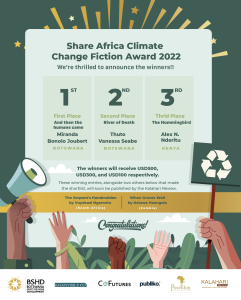A LOOK INTO BOTSWANA’S ENVIRONMENTAL PREDICAMENTS:
Do we look up to a revival or expect the worst?
INTRODUCTION
Botswana is a beautiful land locked country in Africa known for its sub-tropical climate. Being land locked, the country is infested with a plethora of cultural groups originating from different parts of Southern Africa which explains the cultural diversity it embodies. However, like any other developing country, Botswana too is faced with some environmental challenges either on long or short term basis. The main environmental issues currently faced by Botswana in its entirety include water scarcity, environmental pollution and waste management, land degradation, deforestation and Climate change. These are inevitable outcomes of both the changing forces of nature as well as human influences i.e negligence. This article is a concise write-up on environmental issues of concern faced by the country, issues which are evidently imposing changeon the lives of citizenry.
Climate change: Many people are talking about the atmospheric extremities that have recently struck the globe i.e floods, glazier meltdowns, buts let’s stick to Botswana. Atmospheric extremities peculiar to this countryhave since brought turbulences and afflictions to many parts of the country – affecting crop and livestock production.2015 for this country translated to a single percentage increase in temperatures, it is therefore no surprise that the country has since registered deaths of persons whose lives were stole by recent heat waves – as of 2016. It is beyond doubt that our environment is not as it used to be, as deterioration of natural resources has also become evident across the whole country.
As the driest inhabitable continent, Africa is particularly vulnerable to climate change. Evidence which continues to accumulate shows that temperatures are increasing and rainfall distribution patterns are changing throughout the country, changes which have accentuated the shortage of water. Forecasts made by meteorological experts suppose that the situation will worsen between the years 2020 and 2040 henceforth, see an article written on this account http://www.sundaystandard.info/botswana-suffer-worst-water-shortages-2040 (Sunday Standard Reporter 30 Aug 2015).It therefore goes without saying that climate change will profoundly change Botswana’s environment, presenting widespread and significant risks to our ecosystems, native vegetation, water security and agricultural production systems.
Drought and water scarcity: Over the past 6 months, the country has had crippling water shortage predicaments, especially in the Greater Gaborone area following failure of the Gaborone Dam early last year. This shortage has been attributed mainly to the obvious scanty or rather no rainfall in the years 2012-2015, the later has been recorded to be the driest year thus far. Let’s not forgetsubsequent challenges in water supply such as pipeline busts and other technical issues. Clearly, water is becoming an even more scarce resource, more so that there are very few underground sources of water in Botswana and the ground water (which supplies around 70% of the population) is unevenly distributed in time and space.
All rivers, apart from the Okavango and Chobe, are ephemeral. There are few other surface water resources mainly due to low rainfall, high seepage caused generally by sandy soils, and high evaporation rate. The limited supply of surface water and the increasing water demand makes ground water highly important, especially for rural communities. The Botswana Water Utilities Cooperation (WUC) divulged that in 2005, ground water accounted for 80% of the total water consumption. High reliance of ground water poses several challenges and makes ground water protection essential. This is why the public is urged to re-use grey water and improvise measures of collecting and containing water by farmers and corporations, who are especially high consumers of this resource.
Other challenges affiliated to this problem include the high seepage caused by the generally sandy soil found in most regions of Botswana as well as high evaporation rate which results from the extremely high temperatures the country has been experiencing lately; uncertainty, as recharge rate is unknown and the abstraction rates are thought to exceed recharge, resulting in boreholes and wells running dry as is known to be the current condition of the Gaborone Dam whose recent measurement was recorded below 3 percent of its total capacity of 141.4 MCM. A table on the details of all the dams from which water is dispensed to the nation can be seen at http://www.wuc.bw/wuc-content.php?cid=109 dated 15/09/2015.
Water pollution: Water pollution has not always been a prime environmental issue in the country, but now as far as water pollution is concerned, there are problems of high salinity and high cost of provision. Studies show of aquifers, contaminated with nitrates due to leakage from septic tanks and pit latrines, constituting a potential health threat. Discharge effluents from mining operations include high concentrations of various metals polluting the water resources, which is a great concern that puts strain on the water corporation to treat the water at higher costs. Companies are thoroughly encouraged to monitor their water turbidity and treat it before discharging into the sewer line.
Pollution and waste management: It is an unfortunate fact of modern life that the more developed communities become, the more energy and raw materials they consume, the greater the volumes of waste they generate and the more complex and potentially hazardous that waste becomes. Botswana is one of the most developed countries in Africa, although having had a fluctuant currency status. Each year, demands for new infrastructure arise and more companies are founded. All forms of waste i.e solid, liquid, gaseous and hazardous are produced by different industrial and domestic activities in the country. The government has put certain initiatives in place to control the amount of solid and liquid through the collection of domestic waste in homesteads for free and at very low charges from municipalities, private enterprises and schools.
The key form of waste which is of concern in Botswana is hazardous waste as it is a complex waste category with its inherent chemical and physical characteristics. It demands for environmentally sound technologies and know-how as well as clean technologies that simultaneously manage and dispose it in an environmentally friendly way. Nevertheless, Botswana lacks a system covering all the critical steps from importation to final disposal or processing of hazardous and toxic waste owing to limited follow-up of the sources and types of hazardous and toxic waste, lack of modern and specialised treatment/disposal facilities, technical know-how, technically skilled manpower, funds and capabilities of local institutions to take lead in waste management. Therefore, because of a lack of an integrated system, there are challenges such as lack of cooperation among all the stakeholders about the safe management of hazardous and toxic waste. Furthermore, Botswana does not have a systematic regulatory framework regarding monitoring and hazardous and toxic waste management. In addition to the absence of a systematic regulatory framework, inadequate public awareness and dissemination of information about hazardous and toxic waste management, slower progress to phase-out persistent and bio-accumulative waste, and lack of reliable and accurate information on hazardous and toxic waste generation, sources and composition have caused critical challenges to effective hazardous and toxic waste management. An account on a similar matter was recently tackled by the Mmmegi newspaper on an article dated 18/12/15 which talked about current waste transfer stations and can be accessed at the link below;
http://www.mmegi.bw/index.php?sid=1&aid=237&dir=2012/january/tuesday31
Land degradation: This is a serious environmental problem, especially in the eastern parts of the country which is known for its very fertile soils. The main factors contributing to it are the growing human population with increased number of livestock, overgrazing, tree-felling, inappropriate farming techniques and, locally, mining activities. Negative impacts from mining operations include high levels of emissions (especially sulphur dioxide emissions), and sites, which have not been rehabilitated. In 2004, the level of pH, total dissolved solids, sulphates and nickel exceeded allowable concentrations. At the furthest point of monitoring contamination had fallen within acceptable levels except for nitrate and sulphate levels.
Recommendations
Much can be done by all stakeholders to mitigate these issues. National leadership and community commitment is necessary in natural conservation efforts. These stakeholders can all work together to implement incentives and disincentives on natural resources, developing and elevating the status of the National Conservation Strategy, identifying external forces of change, enforcing environmental impact assessment legislation and eliminating overlaps within the current legislation.These efforts should be fronted by resident education and awareness.
-THE END-
Profile:
Duduetsang Baraedi is an Environmental Practitioner. She studied Bachelor of Science (Environmental Health) at the University of Botswana. She currently works for GeoArcheology Research Group (Pty) Ltd as a Research Assistant and wishes to pursue an MA in Environmental Health specializing in Medical Toxicology. This she believes willgive her the green light to carry out accredited research and publications of great significance in the health sector.She is passionate about health in general, as a universal right for all living matter and commits her time to contextualizing factors which symbiotically affect ecological stability in daily life and solutions thereof.





